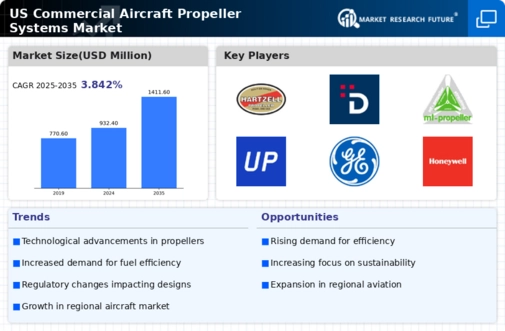The commercial aircraft-propeller-systems market is characterized by a competitive landscape that is increasingly shaped by innovation, sustainability, and strategic partnerships. Key players such as Hartzell Propeller (US), McCauley Propeller Systems (US), and Sensenich Propeller Manufacturing (US) are actively pursuing strategies that emphasize technological advancements and operational efficiencies. Hartzell Propeller (US), for instance, focuses on enhancing propeller performance through advanced materials and design, while McCauley Propeller Systems (US) is known for its commitment to reliability and customer service, positioning itself as a trusted supplier in the market. Sensenich Propeller Manufacturing (US) appears to be leveraging its expertise in composite materials to develop lightweight, fuel-efficient propellers, thereby contributing to the overall competitive dynamics of the sector.
The business tactics employed by these companies reflect a trend towards localizing manufacturing and optimizing supply chains to enhance responsiveness to market demands. The market structure is moderately fragmented, with several players vying for market share, yet the collective influence of these key companies is significant. Their ability to innovate and adapt to changing customer needs is likely to shape the competitive environment, fostering a climate where technological differentiation becomes paramount.
In October 2025, Hartzell Propeller (US) announced a partnership with a leading aerospace research institution to develop next-generation propeller systems that utilize artificial intelligence for performance optimization. This strategic move underscores Hartzell's commitment to integrating cutting-edge technology into its product offerings, potentially setting a new standard in the industry. The collaboration is expected to enhance the efficiency and reliability of propeller systems, aligning with the growing demand for smarter aviation solutions.
In September 2025, McCauley Propeller Systems (US) unveiled a new line of eco-friendly propellers designed to reduce noise and emissions. This initiative not only addresses regulatory pressures but also aligns with the broader industry trend towards sustainability. By prioritizing environmental considerations, McCauley is likely to attract a more diverse customer base, including environmentally conscious operators and airlines.
In August 2025, Sensenich Propeller Manufacturing (US) expanded its production capabilities by investing in advanced manufacturing technologies, including 3D printing. This investment is anticipated to streamline production processes and reduce lead times, thereby enhancing Sensenich's competitive edge. The ability to rapidly prototype and produce customized solutions may position Sensenich favorably in a market that increasingly values agility and responsiveness.
As of November 2025, the competitive trends in the commercial aircraft-propeller-systems market are heavily influenced by digitalization, sustainability, and the integration of AI technologies. Strategic alliances are becoming more prevalent, as companies recognize the need to collaborate in order to innovate effectively. The shift from price-based competition to a focus on technological advancement and supply chain reliability is evident, suggesting that future competitive differentiation will hinge on the ability to deliver innovative, sustainable solutions that meet the evolving needs of the aviation industry.

















Leave a Comment